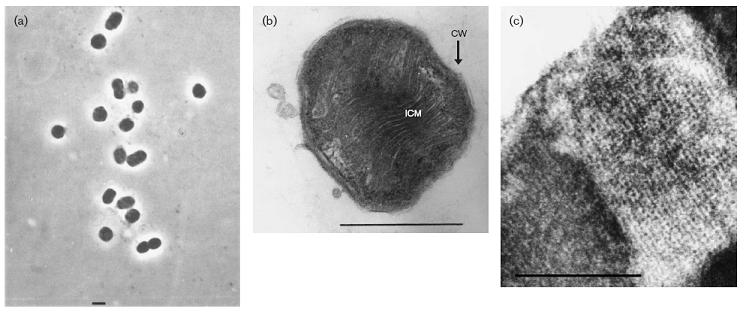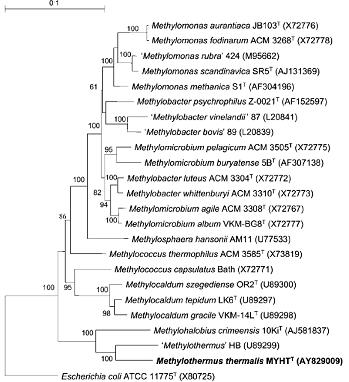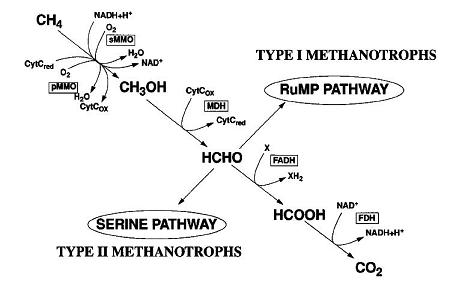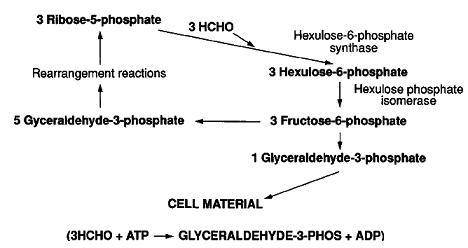Methylothermus thermalis: Difference between revisions
No edit summary |
No edit summary |
||
| Line 144: | Line 144: | ||
==References== | ==References== | ||
[http://www.pnas.org/cgi/reprint/82/4/1170 Carmen Quinto, Humberto De La Vega, Margarita Flores, Jan Leemans, Miguel Angel Cevalios, | [http://www.pnas.org/cgi/reprint/82/4/1170 Carmen Quinto, Humberto De La Vega, Margarita Flores, Jan Leemans, Miguel Angel Cevalios, Marco Aurelio Pardo, Ricardo Azpiroz, Maria De Lourdes Girard, Edmundo Calva, and Rafael Palacios. 1985. "Nitrogenase reductase: A functional multigene family in ''Rhizobium phaseoli''". Proc. Nail. Acad. Sci. USA Vol. 82, pp. 1170-1174.] | ||
Marco Aurelio Pardo, Ricardo Azpiroz, Maria De Lourdes Girard, Edmundo Calva, and Rafael Palacios. 1985. "Nitrogenase reductase: A functional multigene family in ''Rhizobium phaseoli''". Proc. Nail. Acad. Sci. USA Vol. 82, pp. 1170-1174.] | |||
[http://ijs.sgmjournals.org/cgi/content/abstract/55/5/1877 Jun Tsubota, Bulat Ts. Eshinimaev, Valentina N. Khmelenina and Yuri A. Trotsenko. 2005. "''Methylothermus thermalis'' gen. nov., sp. nov.,a novel moderately thermophilic obligate methanotroph from a hot spring in Japan". ''International Journal of Systematic and Evolutionary Microbiology''. 55, 1877–1884.] | [http://ijs.sgmjournals.org/cgi/content/abstract/55/5/1877 Jun Tsubota, Bulat Ts. Eshinimaev, Valentina N. Khmelenina and Yuri A. Trotsenko. 2005. "''Methylothermus thermalis'' gen. nov., sp. nov.,a novel moderately thermophilic obligate methanotroph from a hot spring in Japan". ''International Journal of Systematic and Evolutionary Microbiology''. 55, 1877–1884.] | ||
Revision as of 05:19, 21 April 2008

Classification
Bacteria; Proteobacteria; Gammaproteobacteria; Methylococcales; Methylococcaceae
Species
|
Methylothermus thermalis |
|
NCBI: Taxonomy |
Description and Significance
This organism was found in a Japanese hot spring (location not specified). Methylothermus thermalis grew as small (1–2 mm in diameter), white, semi-transparent colonies with an entire edge and smooth surface were obsevered after 1-2 weeks. Older colonies (1 month) were light brown and more rigid. Unlike most discovered methanotrophs, this species can survive at high temperatures while metabolizing methane and methanol.

Genome Structure
the nifH gene was not detected with PCR analysis. Also, the mmoX gene was not detected by PCR using the respective primer set that is universal for the known mmoX genes of methanotrophs. Describe the size and content of the genome. How many chromosomes? Circular or linear? Other interesting features? What is known about its sequence?


Cell Structure, Metabolism and Life Cycle
The cells grown in liquid culture were mostly represented by coccoids of 0.6–0.8 mm in diameter (Fig. 1a). In contrast, the majority of cells grown on solid medium appeared as short rods, slightly varying in size (0.6–0.8 x 1.0–1.2 mm). The cells were non-motile, and multiplied by normal cell division. The cells showed a typical Gram-negative structure of the cell wall, and the presence of type I intracytoplasmic membrane (ICM) arranged as stacks of vesicular disks (Fig. 1b) that completely filled the cytoplasmic space. Glycogen inclusions and poly-beta-hydroxybutyrate granules usually present in mesophilic methanotrophs were not observed.
Methylothermus thermalis requires methane or methanol as a carbon source to growth. This species can use nitrate, ammonia, urea, tryptophan,lysine, glutamate, formamide and Triss as nitrogen sources, but no growth was obsevered without one of these sources.Interesting features of cell structure; how it gains energy; what important molecules it produces.
Ecology
biogeochemical significance; This species is a methanotroph and therefore it helps to sequester methane from the atmosphere.

References
Author
Page authored by Anthony Heidt and James Goodrow Jr., student of Prof. Jay Lennon at Michigan State University.
